Search results for: 'plate'
-
 Roman Terra Sigillata plate with potter's mark from the Rhineland
Roman Terra Sigillata plate with potter's mark from the RhinelandFound near the Roman city of Novaesium, today's Neuss in Germany, an early Roman foundation and with this one of the oldest cities in Germany.
Price: on request Large very well preserved Roman Terra Sigillata plate from the Rhineland
Large very well preserved Roman Terra Sigillata plate from the RhinelandFound 1971 near the Roman city of Novaesium, today's Neuss in Germany, an early Roman foundation and with this one of the oldest cities in Germany.
Price: on request Roman Terra Sigillata plate from workshop of Virilis from the Rhineland
Roman Terra Sigillata plate from workshop of Virilis from the RhinelandWith potter's mark OF VIRILI. Found near the Roman city of Novaesium, today's Neuss in Germany, an early Roman foundation and with this one of the oldest cities in Germany.
Price: on request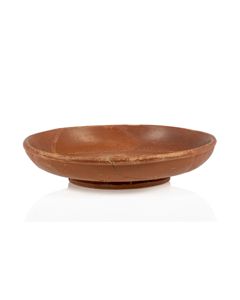 Roman Terra Sigillata plate with potters' mark GERMANI from the Rhineland
Roman Terra Sigillata plate with potters' mark GERMANI from the RhinelandFound near the Roman city of Novaesium, today's Neuss in Germany, an early Roman foundation and with this one of the oldest cities in Germany.
Price: on request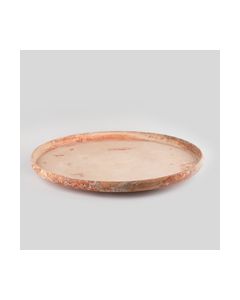 Large and perfectly preserved Roman plate - found in the Mediterranean
Large and perfectly preserved Roman plate - found in the MediterraneanPerfekter Zustand. Vollständig erhalten und nicht restauriert. Sehr selten für eine Keramik dieser Größe. Mit kleinem Standring.
Price: on request Italic chestplate with fine decorations
Italic chestplate with fine decorationsBronze armour from the fascinating transitional period between the late Villanova culture and the early Etruscans. Decorated with bands of zigzag and swastica.
Price: on request Gold-plated Byzantine ring
Gold-plated Byzantine ringWunderschöner Fingerring aus Silber mit deutlichen Resten einer Vergoldung und kunstvollem Dekor. Aus byzantinischer Zeit. Innendurchmesser 18mm bis 19mm.
Price: on request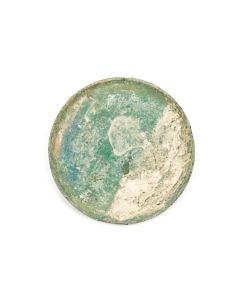 Roman mirror from Baalbek
Roman mirror from BaalbekThe bronze disc is the base plate of a bronze mirror, that was once attached to a handle and coated with a reflective metal layer. Typical for upper class Roman households during Imperial times.
Price: on request Roman mirror from Baalbek
Roman mirror from BaalbekThe bronze disc is the base plate of a bronze mirror, that was once attached to a handle and coated with a reflective metal layer. Typical for upper class Roman households during Imperial times.
Price: on request Viking stirrup mount
Viking stirrup mountOpenwork bronze plate from the 11th century. It was once attached to a horse harness strap. The beautiful decorations are typical of the art of the Vikings.
Price: on request Cypriot bowl
Cypriot bowlVery nice pottery plate painted with circles and accentuations. Cypro-Archaic period.
Price: on request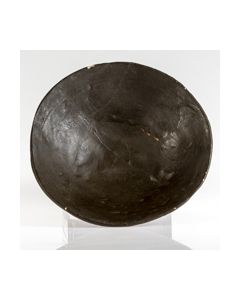 Bowl of the Linear Pottery culture
Bowl of the Linear Pottery cultureLarge flat bowl or deep plate from the earliest peasants of Central Europe, the Neolithic Linear Band Ware settlers. A well preserved piece found in Riekofen in Southern Germany.
Price: on request Tear-shaped Byzantine silver ring
Tear-shaped Byzantine silver ringNicely decorated band. Tear shaped plate with typical byzantine engravings. Inner diameter 18mm to 19mm.
Price: on request Egyptian faience ring showing Bes and Taweret
Egyptian faience ring showing Bes and TaweretThe finger ring with its scene on the plate must have served a protective function for an expectant mother. New Kingdom, approx. 1550 to 1070 BC.
Price: on request Mosaic glass inlay with half mask
Mosaic glass inlay with half maskSkillfully arranged motif that could be combined with a plate of the same motif to show a full face. Made in Egypt during the early Roman Imperial period.
€4,700 Fragment of a disc-headed pin variant
Fragment of a disc-headed pin variantInteresting pin head from Iron Age Luristan. Unusual variant.
€120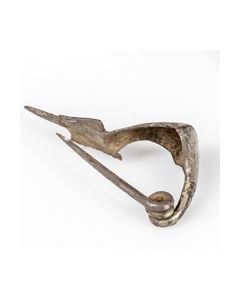 Greek fibula from colonies in Southern Italy
Greek fibula from colonies in Southern ItalyNice silver brooch from the colonies in Southern Italy. Late classical to early hellenistic period.
Price: on request Hellenistic oil lamp manufactured in Asia Minor
Hellenistic oil lamp manufactured in Asia MinorHuman head in high relief on nozzle top, possibly a theater mask. Excellently preserved, from and old German collection, acquired in the 1960s - 1970s.
Price: on request Large Attic terracotta figure of a woman
Large Attic terracotta figure of a womanDelicate work of art, very nicely preserved. From the collection of Professor Robert McElderry (1869 – 1949), acquired in Greece in the 1930s
Price: on request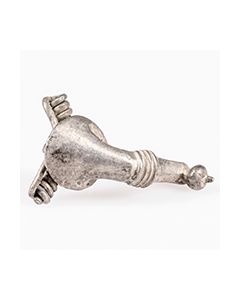 Pannonian trumpet brooch
Pannonian trumpet broochWell preserved Roman fibula made of silver. The type is from the Pannonian provinces of Rome and dates to the 2nd century.
Price: on request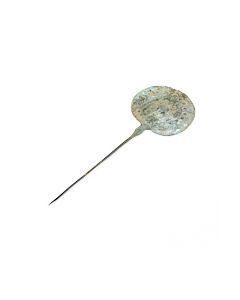 Disc-headed pin from Luristan
Disc-headed pin from LuristanImportant and unique pin type from Iron Age Luristan. Nice specimen with concentrical decoration.
Price: on request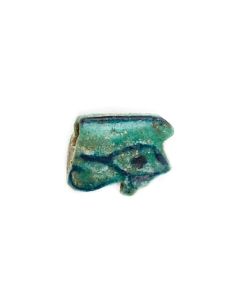 Egyptian Eye of Horus
Egyptian Eye of HorusSmall amulet in form of the Eye of Horus. Popular type of protective amulet from Ancient Egypt.
Price: on request Kusura-type idol from 3rd millenium BC Anatolia examined by Prof. Lambert
Kusura-type idol from 3rd millenium BC Anatolia examined by Prof. LambertIdol aus weißem, feinkristallinem Marmor vom sogenannten Kusura-Typus. Aus der Bronzezeit Anatoliens, 3. Jt. v. Chr. Begutachtet durch Professor W. G. Lambert. Museumswürdig.
Price: on request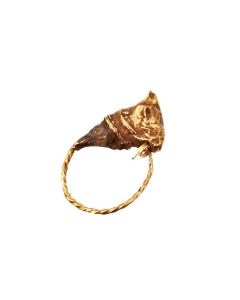 Hellenistic gold earring with bull
Hellenistic gold earring with bullElaborate earring with twisted band and plastic head of a bull. The piece dates to hellenistic times and was skillfully made of gold wire and sheet.
Price: on request Italic fibula with nice incised decoration
Italic fibula with nice incised decorationLarge bronze brooch of a typical boat-shape from Iron Age Italy. A special feature and rarity are the three links of a chain still hanging on the pin.
Price: on request Roman gilt crossbow brooch
Roman gilt crossbow broochInteresting silver fibula from the later Roman Imperial period. From the famous Leo Mildenberg collection.
Price: on request Roman gold ring with intaglio
Roman gold ring with intaglioThe beautiful ring from Roman Imperial times is decorated by an intaglio of vibrant red carnelian stone. It shows the goddess Athena.
Price: on request Brooch from Roman Britain
Brooch from Roman BritainA rare mixture of cicada fibula and trumpet fibula, from the 2nd century. Found on the Isle of Wight.
Price: on request Early Etruscan fibula
Early Etruscan fibulaThe early Etruscan bronze brooch is characterized by its artistically decorated bow. A find from northern Italy.
€140 Roman jar with handle
Roman jar with handleRoman Empire, 3rd century AD, excellently preserved. From and old German collection, acquired in the 1960s - 1970s.
Price: on request Hellenistic clay figurine of a standing woman
Hellenistic clay figurine of a standing womanGood condition, white grounding partially preserved. Acquired 1978 at Davies Antiques Gallery, London.
Price: on request Etruscan "a baule" type earrings
Etruscan "a baule" type earringsSkilfully made pair of gold earrings with filigree. The ancient jewellery is from the Golden Age of the Etruscans around the 6th century BC.
Price: on request Roman silver knee brooch
Roman silver knee broochNice specimen with characteristic bend in its bow and incised decorations. From the Danubian provinces of the Roman Empire.
Price: on request Etruscan "a baule" type earrings
Etruscan "a baule" type earringsSkilfully made pair of gold earrings with filigree. The ancient jewellery is from the Golden Age of the Etruscans around the 6th century BC.
Price: on request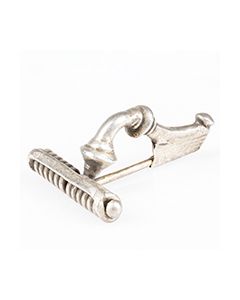 Roman silver fibula
Roman silver fibulaBeautiful brooch from the eastern Roman provinces. Remains of an original gold plating can still be seen on the surface.
Price: on request Large early Etruscan boat-shaped fibula
Large early Etruscan boat-shaped fibulaThe magnificent specimen stands out due to its rich and beautiful decorations. The boat-shaped type, also known as the Navicella fibula, was known in the regions around the Alps roughly 700 BC.
€2,440

